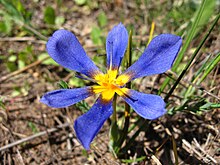Calydorea
| Calydorea | |
|---|---|

| |
| Calydorea xiphioides | |
| Scientific classification | |
| Kingdom: | Plantae |
| Clade: | Tracheophytes |
| Clade: | Angiosperms |
| Clade: | Monocots |
| Order: | Asparagales |
| Family: | Iridaceae |
| Subfamily: | Iridoideae |
| Tribe: | Tigridieae |
| Genus: | Calydorea Herb.[1] |
| Type species | |
| Calydorea speciosa (J.D. Hooker) Herbert
| |
| Synonyms[2] | |
| |
Calydorea is a small genus of perennial, herbaceous and bulbous plants in the family Iridaceae native to Mexico and South America.[2] The plants in the genus are small with tunicated bulbs. The flowers are light blue, violet, white, or yellow, depending on the species, of which there are around twenty. Taxonomists considered that the already known genera Salpingostylis (endemic from Florida), Cardiostigma (from Mexico), Catila (from Brazil) and Itysa (from Venezuela) are not enough different from each other to justify their taxonomic segregation and, for this reason, all of them are now included in Calydorea.[3]
The genus name is derived from the Greek words caly, meaning "sheathed", and dorea, meaning "spear".[4]
- Species[5]
- Roitman & A.Castillo, Bol. Soc. Argent. Bot. 40: 311 (2005). Uruguay.
- (Ravenna) Goldblatt & Henrich, Ann. Missouri Bot. Gard. 78: 511 (1991). Southern Brazil to North Eastern Argentina. (Syn.: Catila amabilis Ravenna)
- R.C.Foster, Contr. Gray Herb. 155: 46 (1945). Bolivia to North Eastern Argentina.
- Klatt, Abh. Naturf. Ges. Halle 15: 387 (1882). Bolivia to Uruguay.
- Ravenna, Onira 10: 40 (2005). Brazil (Paraná).
- Ravenna, Onira 9: 23 (2003). Chile (Maule).
- (Klatt) Baker, J. Bot. 14: 187 (1876). Brazil to Bolivia.
- Muñoz-Schick, Gayana, Bot. 60: 104 (2003). Chile (Maule).
- Klatt, Abh. Naturf. Ges. Halle 15: 387 (1882). Colombia to Venezuela.
- Ravenna, Bol. Soc. Argent. Bot. 10: 311 (1965). South Eastern and Southern Brazil.
- Baker, J. Bot. 14: 188 (1876). Brazil (Piauí, Mato Grosso).
- Ravenna, Onira 10: 41 (2005). Brazil (Paraná).
- (Herb.) Baker, J. Bot. 14: 188 (1876). Central and South Western Mexico.
- (Klatt) Baker, J. Bot. 14: 188 (1876). S. Brazil.
- (R.C.Foster) Goldblatt & Henrich, Ann. Missouri Bot. Gard. 78: 510 (1991). Mexico (Mexico State).
- Roitman & J.A.Castillo, Bol. Soc. Argent. Bot. 42: 321 (2007). Paraguay to Argentina (Corrientes Province).
- (Herb.) Baker, J. Bot. 14: 188 (1876). Uruguay.
- Griseb., Abh. Königl. Ges. Wiss. Göttingen 24: 324 (1879). Northern Argentina.
- Ravenna, Onira 6: 14 (2001). Argentina (Córdoba).
- (Ravenna) Goldblatt & Henrich, Ann. Missouri Bot. Gard. 78: 511 (1991). Venezuela. (syn.: Itysa venezolensis Ravenna)
- (Poepp.) Espinosa, Revista Chilena Hist. Nat. 26: 18 (1922). Central Chile.
References[]
- ^ Edwards's Bot. Reg. 29: 85 (1843).
- ^ a b Kew World Checklist of Selected Plant Families
- ^ Goldblatt, P. & J.E. Henrich. 1991. Calydorea Herbert (Iridaceae-Tigridieae): Notes on this New World genus and reduction to synonymy of Salpingostylis, Cardiostigma, Itysa and Catila. Annals of the Missouri Botanical Garden 78: 504-511
- ^ Manning, John; Goldblatt, Peter (2008). The Iris Family: Natural History & Classification. Portland, Oregon: Timber Press. pp. 233–35. ISBN 0-88192-897-6.
- ^ Royal Horticultural Society, Kew. A detailed checklist for genus Calydorea .
Bibliography[]
- Goldblatt, P. & J.E. Henrich. 1991. Calydorea Herbert (Iridaceae-Tigridieae): Notes on this New World genus and reduction to synonymy of Salpingostylis, Cardiostigma, Itysa and Catila. Annals of the Missouri Botanical Garden 78: 504-511
- Muñoz-Schick, M. Tres nuevas Monocotiledóneas descubiertas en Chile: Alstroemeria mollensis M.Muñoz et A.Brinck (Alstroemeriaceae), Miersia chilensis var. bicolor M.Muñoz (Gilliesiaceae) y Calydorea chilensis M.Muñoz (Iridaceae). Gayana Bot., 2003, vol.60, no.2, p.101-106.
- Roitman, G. & Castillo, A. Calydorea alba (Iridaceae, Tigrideae), a new species from Uruguay. Boletín Sociedad Argentina Botánica. 40 (3-4) 2005.
External links[]
| Wikimedia Commons has media related to Calydorea. |
| Wikispecies has information related to Calydorea. |
Categories:
- Iridaceae genera
- Iridaceae